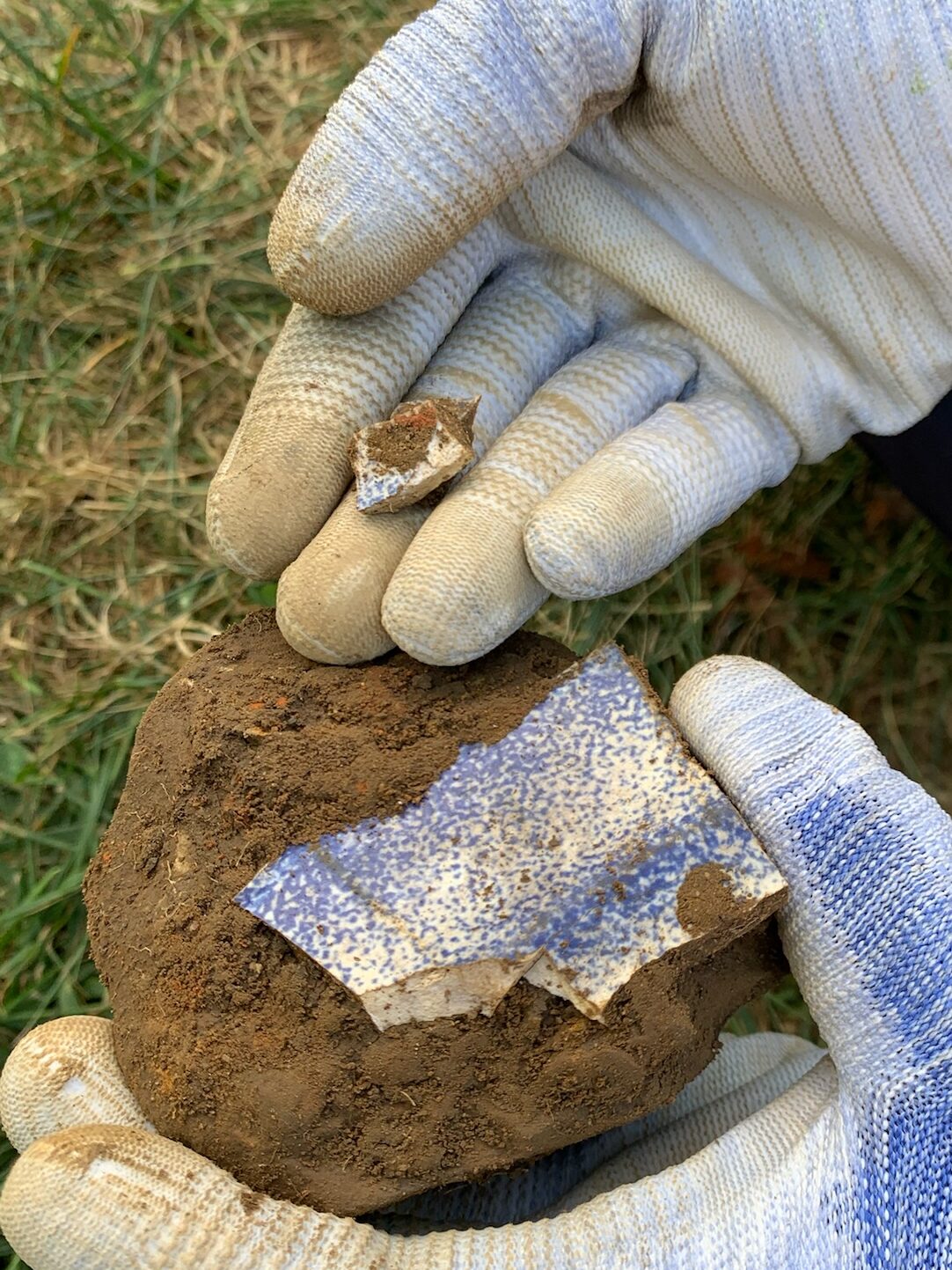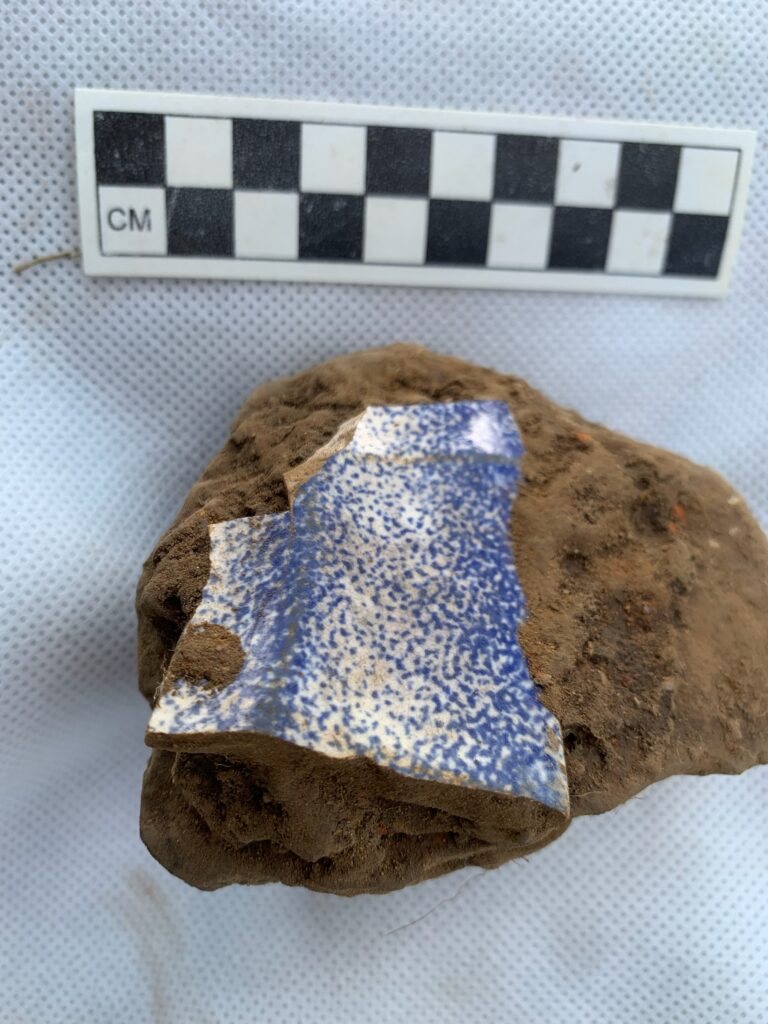This week, our readings centered around the idea of object biographies, that overall aim to tell the story of an artifact, from its production to deposition within an archaeological site. Considering material culture in its different stages of production, consumption and use can help archeologists to build an understanding of the relationship between humans and objects (Gosden et al., 2010). As humans and objects gather time, move and change, they transform, and the relationship between the object and humans becomes intertwined (Gosden et al., 2010).
As we wrap up our excavations at the Bishop’s Cabin site, our class has begun to examine several types of ceramic artifacts ranging in size, complexity, quality and material that may provide insight into the early years of Kenyon. Among a variety of ceramics, this post aims to build an object biography of one of our largest ceramic pieces: a whiteware sherd with blue sponge patterns. This object was imbedded against a rock, found on the northward wall of the cabin. Due to the shape of the sherd, it may have been a piece of a plate or platter, and is about 6 cm in length.

Sponge-printed whiteware from the dining hall excavations.
The state of Ohio was established in the year 1803, and many citizens and immigrants pushed towards the westward expansion of the US. The state of Ohio was seen as a frontier that could be “conquered” or “tamed”, and the soil was promising for aspiring farmers. This made the West, and specifically Ohio, appealing to those looking for new land to occupy. The first students would have arrived from the college’s previous location in Worthington in 1828, where the first buildings would have been rustic, like the cabin at the Bishop’s Cabin site. Therefore, this sherd would have arrived and been deposited after the year 1828. In terms of where these early ceramic materials at Kenyon were being manufactured, it is unsure whether these ceramics would have been manufactured in the United States or imported from Europe, where they were originally created. The underlying material of this ceramic, is called White earthenware. White earthenwares had been developed throughout Europe, including England, France, Italy, Slovenia and Switzerland (Maggetti, 2010). This genre of ceramic was mass-produced between the years of 1750 and 1900 (Maggetti, 2010). White earthenwares became the “porcelain of the poor man”, and replaced more expensive, traditional forms of ceramic (Maggetti, 2010). Its probable that these ceramic techniques would have spread into the United States during this time as well. Considering the mass-production and cheap material, it is entirely possible that White earthenwares were being produced in the Midwest.

Sponge-printed whiteware as it was found embedded on a rock
In terms of the design, the blue patterns would have been applied using a sponge technique. Spongeware would have been a relatively cheap form of decoration, and been produced between the years of 1840-1940 (Henderson, 1999). The sponge patterns would have been applied either before or after firing, and could range from non-uniform patterns like the sherd above, or specific floral designs (Tennis, 1997). We have found several sherds at the Bishop’s cabin site with organized floral patterns, and it’s possible that these sherds could have been made with similar techniques.
Overall, the ceramics found at the Bishop Cabin’s site can help us to understand possible the commercial, industrial, and economic systems during the college’s early years, just a short time after the state’s establishment in 1803. Similarly, these object biographies provide us with cultural knowledge. As we attempt to discover the function of one of the first buildings at Kenyon, ceramics like these can help with identifications of the building as a multifunctional dining hall, residence or academic building. Furthermore, our class will continue to conduct research and built object biographies of artifacts to help us understand social, cultural and economic systems occurring in Kenyon’s earliest years.
Works Cited
Gosden & Marshall (1999) The cultural biography of objects, World Archaeology, 31:2,169-178, DOI: 10.1080/00438243.1999.9980439
Henderson, Z. “Archaeological investigations.” Culna 1999.54 (1999): 07-09.
Maggetti M. Archaeometric Analyses of European 18th–20th Century White Earthenware—A Review. Minerals. 2018; 8(7):269. https://doi.org/10.3390/min8070269
Tennis, Cynthia L. “Ceramic Patterns and Variations.” Archaeology at the Alamodome: Investigations of a San Antonio Neighborhood in Transition: 1.
Leave a Reply